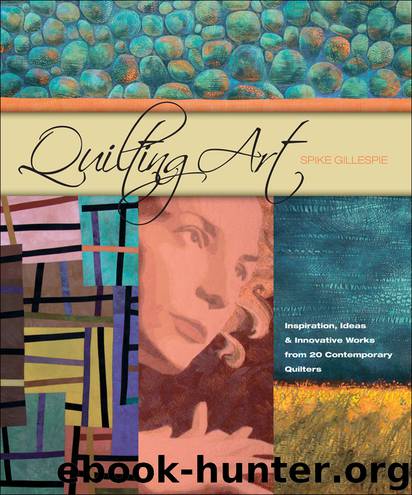Quilting Art by Spike Gillespie

Author:Spike Gillespie
Language: eng
Format: epub
Publisher: MBI
Published: 2009-06-14T16:00:00+00:00
BIG LEAF 2 | Dominie Nash | 2006 | 57″ x 48″ | Cotton, silk organza | Whole cloth; appliqué, hand embroidery | Dominie says, “The fabric printed with large sycamore leaves was used in this triptych, which ended up looking like a kimono, although I hadn’t planned it that way.” Photograph by Mark Gulezian/Quicksilver
Once Nash has a good idea of composition, she moves the work back to the design table and bastes the pieces together, sometimes rearranging a bit as she goes. Then she sews around all the pieces with her machine, leaving the edges raw. When that stage is completed, the top is returned to the wall, at which point the artist decides where to place pieces of organza, which is featured in nearly all of her work. When the organza is in place, it, too, must be basted and then sewn. “The process is very tedious,” says Nash. “It’s the part I like least.”
At that point, if she thinks her work still needs a bit more, she’ll embellish with crayons and pastels. “Then it’s ready to be quilted,” she says. “So I sit at the machine and within each shape decide how I want to quilt it. Whatever the fabric and shape require. Then it’s done except the facing. A lot of people who make quilts do a binding. I don’t like to do that; I think it stops the design. It’s a traditional quilt thing. There’s no reason to do it on an art quilt.”
Community is essential to her growth. “The quilt groups I belong to are very important to me,” she says. “There’s one in DC, one that meets once a year in New York, and one in Europe—I go over twice a year for meetings. In the group I attend regularly [the DC group] everyone’s really professional, but we’re still a little too polite when we do critiques.”
Nash attributes this over-politeness to a “hangover” from the days of quilting bees when women came together for, among other things, emotional support. But with art quilts, she and her peers want to move beyond that. “So we have hired people to come and give us critiques,” she says. “Our most recent critic is a curator and a writer. He’s juried a lot of shows, and he’s friendly toward textiles. He didn’t know a lot of technical stuff, but we didn’t want that. He treated it like an art form. His background is fine arts. He didn’t care how something was made. He just looked at the work.”
These days, Nash exhibits her work regularly, and she’s well known and respected. But she remembers the early days, working for recognition. “I’ve had the usual experience where I thought, This is the most wonderful thing in the world and they didn’t take it, and I’d think, How can this happen? and I cried. I don’t cry anymore.”
She attributes some of her success to persistence. “For a while I entered everything that came along. If there was an opportunity, I would take it.
Download
This site does not store any files on its server. We only index and link to content provided by other sites. Please contact the content providers to delete copyright contents if any and email us, we'll remove relevant links or contents immediately.
On Writing A Memoir of the Craft by Stephen King(4664)
The Doodle Revolution by Sunni Brown(4503)
A Simplified Life by Emily Ley(3969)
Mummy Knew by Lisa James(3521)
Marijuana Grower's Handbook by Ed Rosenthal(3512)
Better Homes and Gardens New Cookbook by Better Homes & Gardens(3371)
Paper Parties by Erin Hung(3308)
Figure Drawing for Artists by Steve Huston(3271)
Draw Your Day by Samantha Dion Baker(3126)
The Genius of Japanese Carpentry by Azby Brown(3039)
Japanese Design by Patricia J. Graham(3000)
The Code Book by Simon Singh(2857)
Lions and Lace by Meagan Mckinney(2845)
Dangerous Girls by Haas Abigail(2839)
The Curated Closet by Anuschka Rees(2802)
How to Make Your Own Soap by Sally Hornsey(2741)
The Checklist Manifesto by Atul Gawande(2657)
The Wardrobe Wakeup by Lois Joy Johnson(2635)
Zero to Make by David Lang(2627)
